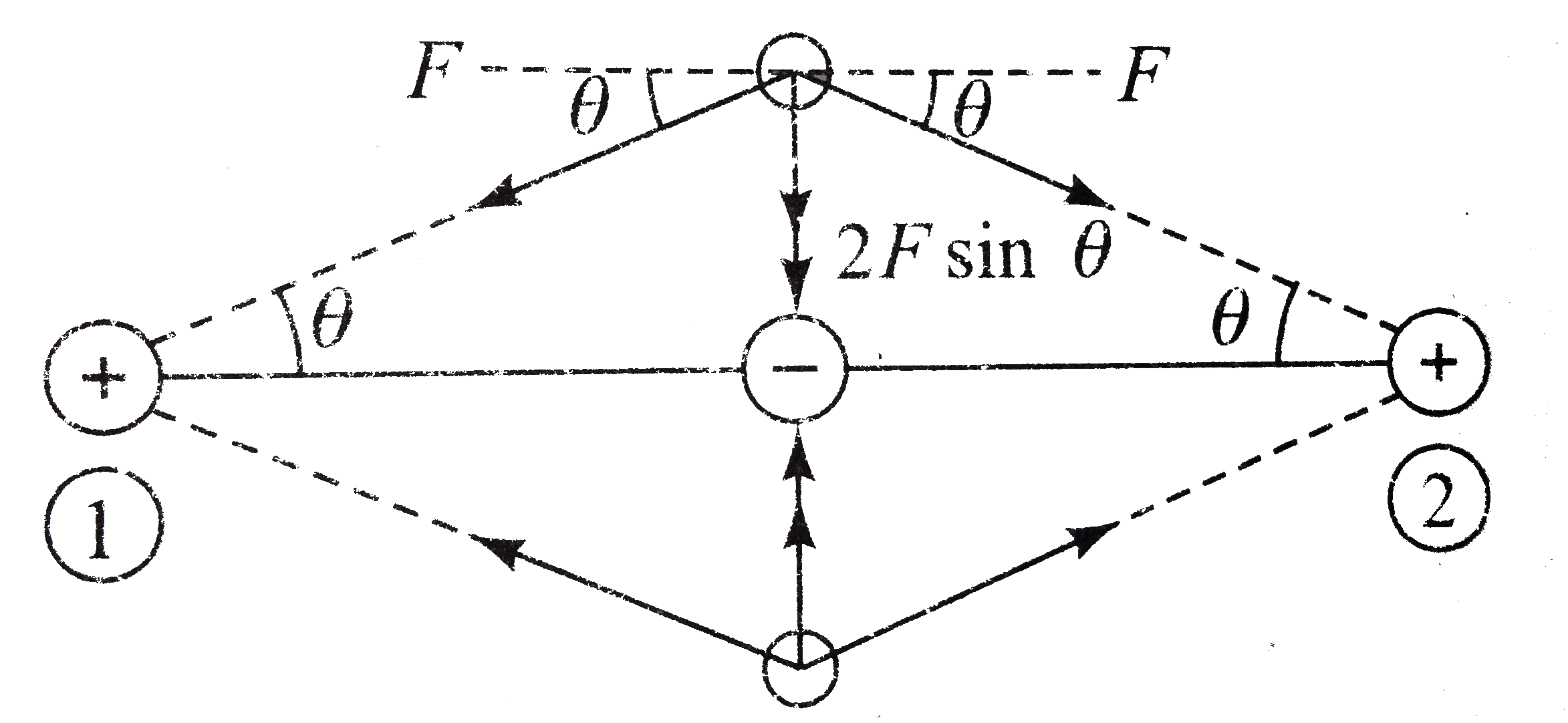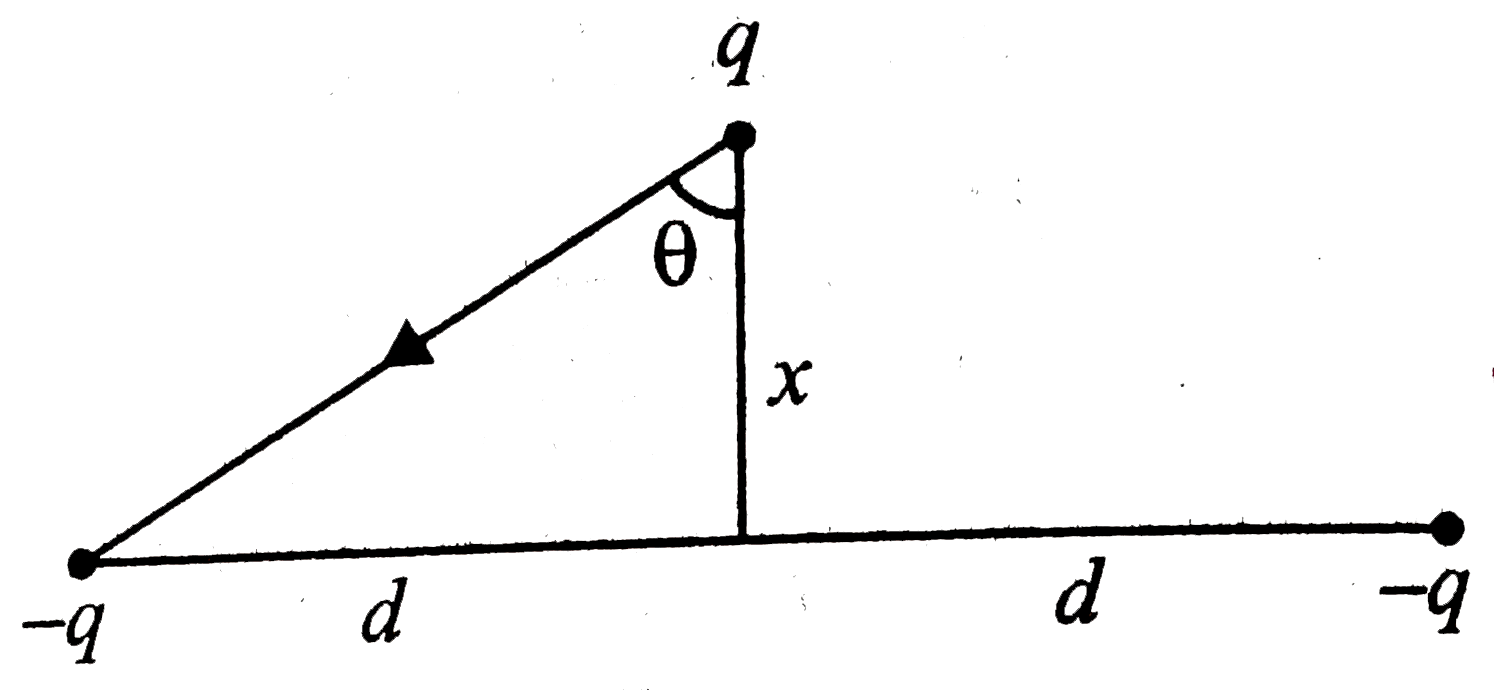In the arrangement shown in fig. two positive charges, +Q each,are fixed. Mark the correct statement(s) regarding a third charged particle −q place at the midpoint P that can be displaced along or perpendicular to the line connecting the charges.

(a) There is always a restoring force toward its original position. The particle (negative charge) will perform oscillation. (the case of stabel equilibrium.)

(b) Let negative chage be displaced towaed charge(1). then →F will be more than →F. The negative charge will experience net force toward charge (1) or in the direction of its displacement. The negative charge is under ustable equilbrium.

Topper's Solved these Questions
- COULOMB LAW AND ELECTRIC FIELDBOOK - CENGAGE PHYSICSCHAPTER - COULOMB LAW AND ELECTRIC FIELDEXERCISE - Subjective
32 Videos
- COULOMB LAW AND ELECTRIC FIELDBOOK - CENGAGE PHYSICSCHAPTER - COULOMB LAW AND ELECTRIC FIELDEXERCISE - Single Correct
47 Videos
- COULOMB LAW AND ELECTRIC FIELDBOOK - CENGAGE PHYSICSCHAPTER - COULOMB LAW AND ELECTRIC FIELDEXERCISE - Solved examples
10 Videos
- COMMUNICATION SYSTEMBOOK - CENGAGE PHYSICSCHAPTER - COMMUNICATION SYSTEMEXERCISE - QUESTION BANK
19 Videos
- Current ElectricityBOOK - CENGAGE PHYSICSCHAPTER - Current ElectricityEXERCISE - QUESTION BANK
40 Videos
Similar Questions
Two charges −q each are fixed separated by distance 2d. A third charge q of mass m placed at the mid-point is displaced at the mid-point is placed slightly by x(x<<d) perpendicular to the line joining the two fixed charges as shown in Fig. Show that q will perform simple harmonic oscillarion of time period.
T=[8π3∈0md3q2]1/2

View SolutionTwo positive point charges , each Q , are fixed at separation d. A third charge q is placed in the middle. Describe the equilibrium of the third charge.
View Solution
Knowledge Check
In the arrangement shown in fig. The two point charge are in equilibrium. The infinete wire is fixed in the horizontal plane, and the two point charges are placed one above and the other below the wire. Consifering the gravitational effect of the earth, the nature of q1 and q2 can be
 Aq1→ positive, q2→ positiveBq1→ positive, q2→ NegativeCq1→ Negative, q2→ negativeDq1→ Negative, q2→ positive
Aq1→ positive, q2→ positiveBq1→ positive, q2→ NegativeCq1→ Negative, q2→ negativeDq1→ Negative, q2→ positiveTwo point charges q each are fixed at (a,0) and (-a,0). A third charge Q is placed at origin. Electrons potential energy of the system will
Aincrease if Q is slightly displaced along x-axisBdecrease if Q is slightly displaced along x-axisCincrease if Q is slightly displaced along y-axisDdecrease if Q is slightly displaced along y-axisTwo identical charges +Q are kept fixed some distance apart.A small particles P with charge q is placed midway between them . If P is given a small displacement Δ ,it will undergo simple harmonic motion if
(i) q is positive and Δ is along the line joining the charges
(ii) q is positive and Δ is perpendicular to the line joining the charges
(iii) q is negative and Δ is perpendicular to the line joining the charges
(iv) q is positive and Δ is along the line joining the chargesA(i),(ii)B(i),(iii)C(ii),(iii)D(i),(iv)
Two small particles charged with equal positive charges Q each, are fixed apart at a distance 2a. Another small particle having a charge q lies midway between the fixed charges. Show that
(i) For small displacement (relative to a) along line joining the fixed charges, the middle charge executes SHM'if it is +ve and
(ii) For small lateral displacement, it executes SHM ifit is-ve. Compare the frequencies of oscillation in the two cases
View SolutionTwo infinitely long line charges having charge density λ each are parallel to each other and separated by distance d. A charge particle of mass m and charge q is placed at mid point between them. This charge displaced slightly along a line AB which is perpendicular to the line charges and in the plane of the charges. prove that the motion of the particle will be SHM for small displacement and λq>0 Neglect gravity. Find the time period.

View SolutionTwo points charges , each Q , are fixed at separation 2d. A charged particle having charge q and mass m is placed between them.
(a) Now this charged particle is slightly displaced along the line joining the charges , slow that it will execute simple harmonic motion and find the time period of oscillation.
(b) If charge q is negative and it is displaced slightly perpendicular to the line joining the charges , repeat the part (a).
View SolutionTwo electrons each are fixed at a distance '2d'. A third charge proton placed at the midpoint is displaced slightly by a distance x(x<<d) perpendicular to the line joining the two fixed charges. Proton will execute simple harmonic motion having angular frequency : (m = mass of charged particle)
View SolutionFour positive charges (2√2−1)Q are arranged at the four corners of a square. Another charge q is placed at the center of the square. Resulting force acting on each corner charge is zero if q is
View Solution
